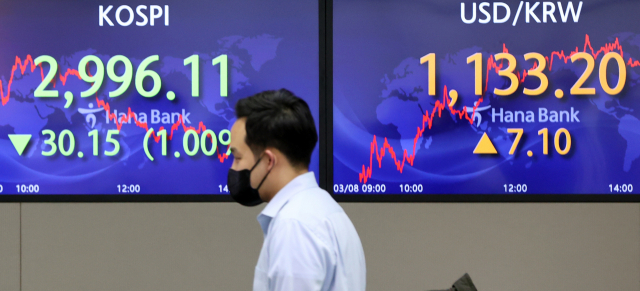Won dollar exchange rate of 1,133 won… Best in 4 months
Korea’s Treasury Bond Interest Rate Soars, Over 2% of 10-Year Bonds
KOSPI down 3,000 in 7 trading days
 viewer
viewer
The volatility of the domestic foreign exchange and financial markets is increasing due to anxiety arising from the rise in US Treasury yields. The won-dollar exchange rate surpassed the 1,130 won range, hitting a year-round high, and the 10-year Treasury Bond yield exceeded 2%. Along with the rise in US Treasury yields, the strong dollar is expected to continue for the time being.
On the 8th, the won-dollar exchange rate in the Seoul foreign exchange market closed by 1,133 won and 20 before the previous trading day by 7 won and 10 times. On this day, the won-dollar exchange rate started at 1,128 won, up 1 won 90 before the previous trading day, and the intraday uptrend expanded. In the end, the exchange rate rose by more than 50 won compared to the beginning of the year (1,082 won 10 before), showing the highest level since November 4 last year (1,137 won 70 before) based on the closing price.
On this day, KOSPI closed the transaction at 2,996.11, down 30.15 points (1.00%) from the previous trading day. It is only 7 trading days since February 24 (2,994.98) that the KOSPI fell below the 3,000 line based on the closing price. In the securities market, institutions and foreigners net sold 3781 billion won and 129.2 billion won, respectively, leading the index decline. Individual investors net bought 525.8 billion won, but it was not enough to defend the index. In the aftermath of the rise in US Treasury yields, the final bid rate for 3-year Treasury bonds rose by 7.3bp (1bp=0.01%) from the 5th to 1.139% per annum. This is the first time since March 25 last year that the 3-year Treasury Bond interest rate has exceeded 1.1% per year. The 10-year Treasury Bond interest rate also rose 3.6bp from the previous trading day to 2.028% per year, the highest level since March 5 last year.
In the foreign exchange market, the US employment index in February turned out to be better than expected, and the dollar was strong. As the US prepares a large-scale economic stimulus package worth $1.9 trillion, the US Treasury bond rate hike is expected to continue for the time being. The dollar’s strength could continue as a hedging tendency appears in the foreign exchange and financial markets. In addition, Ningji-zer, deputy head of the China National Development and Reform Commission, remarked that the foundation for China’s economic recovery is not solid, emphasizing the weakening of the won. Concerns over the recovery of China’s economy led to an increase in the yuan against the dollar and the won also weakened. On this day, the Shanghai Composite Index closed at 3,421.41, down 2.30% from the previous trading day. The Shanghai Index hit the lowest this year based on the closing price. In addition, the Shenzhen component index, which has a high proportion of technology stocks, plunged 3.81%. In both meetings, while the economic stimulus was reduced, the exports to China announced the day before came out too well, and it is analyzed that this has increased the possibility of austerity. In addition, the passage of stimulus measures in the US weakened investor sentiment in the Chinese stock market, highlighting the burden of rising US Treasury yields on the one hand.
Park Sang-hyun, a researcher at Hi Investment & Securities, said, “The strong dollar arising from the rise in US interest rates can be seen as the biggest factor. As a result, if the stock market is unstable, the weakening of the won could continue for a while.”
/ Reporter Jo Ji-won [email protected], Reporter Shim Woo-il [email protected]
< 저작권자 ⓒ 서울경제, 무단 전재 및 재배포 금지 >
